Nail gun injuries to the head with minimal neurological consequences: a case series
- PMID: 27080512
- PMCID: PMC4832548
- DOI: 10.1186/s13256-016-0839-1
Nail gun injuries to the head with minimal neurological consequences: a case series
Abstract
Background: An estimated 3700 individuals are seen annually in US emergency departments for nail gun-related injuries. Approximately 45 cases have been reported in the literature concerning nail gun injuries penetrating the cranium. These cases pose a challenge for the neurosurgeon because of the uniqueness of each case, the dynamics of high pressure nail gun injuries, and the surgical planning to remove the foreign body without further vascular injury or uncontrolled intracranial hemorrhage.
Case presentation: Here we present four cases of penetrating nail gun injuries with variable presentations. Case 1 is of a 33-year-old white man who sustained 10 nail gunshot injuries to his head. Case 2 is of a 51-year-old white man who sustained bi-temporal nail gun injuries to his head. Cases 3 and 4 are of two white men aged 22 years and 49 years with a single nail gun injury to the head. In the context of these individual cases and a review of similar cases in the literature we present surgical approaches and considerations in the management of nail gun injuries to the cranium. Case 1 presented with cranial nerve deficits, Case 2 required intubation for low Glasgow Coma Scale, while Cases 3 and 4 were neurologically intact on presentation. Three patients underwent angiography for assessment of vascular injury and all patients underwent surgical removal of foreign objects using a vice-grip. No neurological deficits were found in these patients on follow-up.
Conclusions: Nail gun injuries can present with variable clinical status; mortality and morbidity is low for surgically managed isolated nail gun-related injuries to the head. The current case series describes the surgical use of a vice-grip for a good grip of the nail head and controlled extraction, and these patients appear to have a good postoperative prognosis with minimal neurological deficits postoperatively and on follow-up.
Keywords: Brain; Nails; Neurosurgery; Penetrating trauma.
Figures
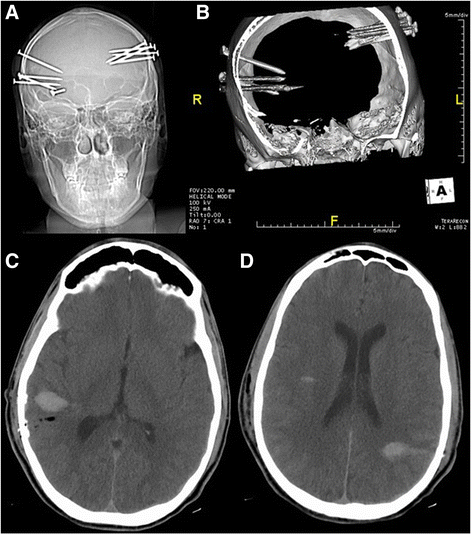
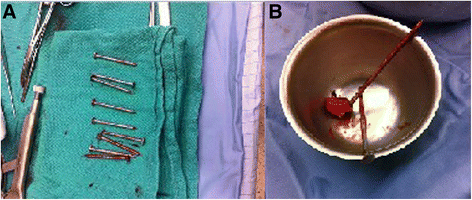
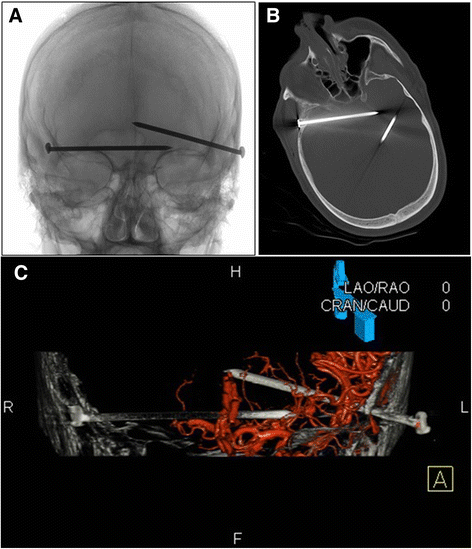
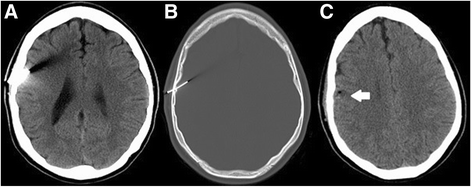
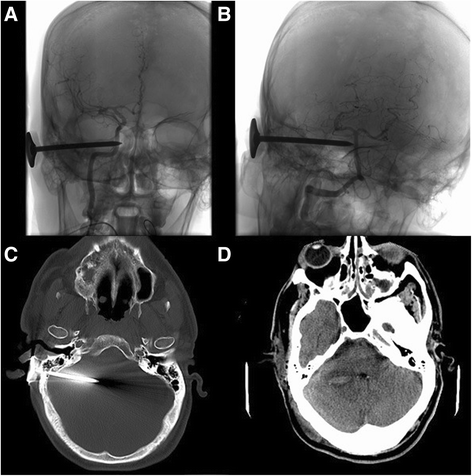
Similar articles
-
Self-inflicted nail-gun injury with 12 cranial penetrations and associated cerebral trauma. Case report and review of the literature.J Neurosurg. 2006 May;104(5):828-34. doi: 10.3171/jns.2006.104.5.828. J Neurosurg. 2006. PMID: 16703892 Review.
-
Penetrating brain injury caused by nail guns: two case reports and a review of the literature.Brain Inj. 2012;26(13-14):1756-62. doi: 10.3109/02699052.2012.700085. Epub 2012 Jul 23. Brain Inj. 2012. PMID: 22823496 Review.
-
[A case of penetrating head injury caused by nail-gun].No Shinkei Geka. 1993 Apr;21(4):373-7. No Shinkei Geka. 1993. PMID: 8474595 Japanese.
-
Ten self-inflicted intracranial penetrating nail gun injuries.Neurosciences (Riyadh). 2015 Jul;20(3):267-70. doi: 10.17712/nsj.2015.3.20150088. Neurosciences (Riyadh). 2015. PMID: 26166596 Free PMC article.
-
Penetrating craniocerebral injuries from nail-gun use.J Clin Neurosci. 2007 Jul;14(7):678-83. doi: 10.1016/j.jocn.2006.02.017. Epub 2007 Apr 23. J Clin Neurosci. 2007. PMID: 17452105
Cited by
-
Surviving the Scene in Civilian Penetrating Brain Injury: Injury Type, Cause and Outcome in a Consecutive Patient Series in Austria.Front Surg. 2022 Jun 28;9:923949. doi: 10.3389/fsurg.2022.923949. eCollection 2022. Front Surg. 2022. PMID: 35836601 Free PMC article.
-
Management outcome of a patient with a self-inflicted multiple intracranial nail impalement in a tertiary hospital in Uyo: illustrative case.J Neurosurg Case Lessons. 2025 Jun 16;9(24):CASE25103. doi: 10.3171/CASE25103. Print 2025 Jun 16. J Neurosurg Case Lessons. 2025. PMID: 40523352 Free PMC article.
-
Survival after multiple nail gun injuries to the brain, lung, and heart: a case report and a review of the literature.J Int Med Res. 2021 Oct;49(10):3000605211049923. doi: 10.1177/03000605211049923. J Int Med Res. 2021. PMID: 34648362 Free PMC article. Review.
-
Double penetration wound: A nail gun injury involving the head and heart.Radiol Case Rep. 2020 Jan 22;15(4):334-338. doi: 10.1016/j.radcr.2019.11.021. eCollection 2020 Apr. Radiol Case Rep. 2020. PMID: 31993095 Free PMC article.
-
Treatment of a self-inflicted intracranial nail gun injury.BMJ Case Rep. 2021 Jan 11;14(1):e237122. doi: 10.1136/bcr-2020-237122. BMJ Case Rep. 2021. PMID: 33431447 Free PMC article.
References
-
- Beaver AC, Cheatham ML. Life-threatening nail gun injuries. Am Surg. 1999;65:1113–6. - PubMed
Publication types
MeSH terms
LinkOut - more resources
Full Text Sources
Other Literature Sources

